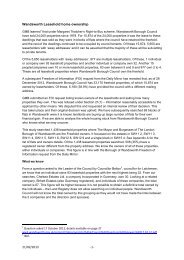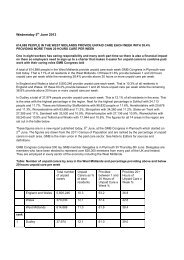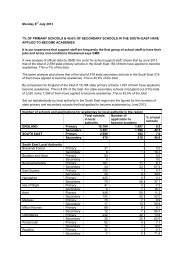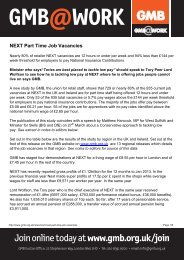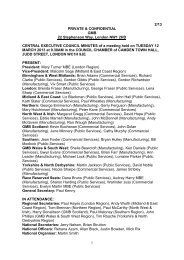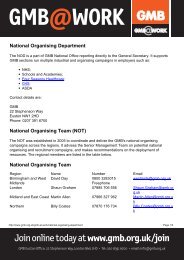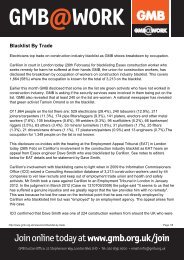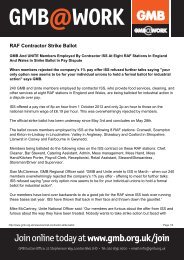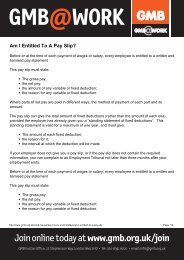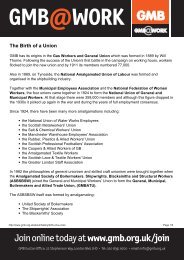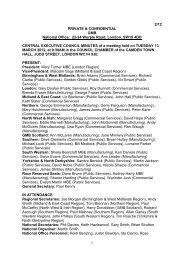WO toolkit 2012 complete.pdf - GMB
WO toolkit 2012 complete.pdf - GMB
WO toolkit 2012 complete.pdf - GMB
Create successful ePaper yourself
Turn your PDF publications into a flip-book with our unique Google optimized e-Paper software.
SECTION 5.18<br />
GROUP THREE<br />
MATERNITY&PARENTAL RIGHTS<br />
18. Can I take maternity leave?<br />
All women employees are entitled to 52 weeks maternity leave whatever their length of service or the<br />
number of hours worked.Maternity leave is divided into two parts Ordinary Maternity Leave(OML),<br />
which covers the first 26 weeks,and Additional Maternity Leave(AML)which covers the remaining<br />
26 weeks.Your rights are different during the two periods of leave.<br />
Your leave can start at any time after the 11th week before the expected week of childbirth.It is up to<br />
you to decide when you start your maternity leave,so long as the start date is after the 11th week<br />
before your due date.The latest maternity leave can start is the date your baby is born.You count your<br />
26 weeks from the date you start your leave.To take maternity leave you should:<br />
• Notify your employer(a)that you are pregnant(b)the expected week of childbirth and(c)the date<br />
on which you intend leave to start,before the end of the 15th week before your due date.Your<br />
employer can ask you to put this information in writing.<br />
• You can amend the intended start date of your leave with at least 28 days notice where reasonably<br />
practicable.<br />
• Your employer must inform you in writing of your leave period and expected week of return within<br />
28 days of your providing notice.Your employer should assume you will take AML and give you a<br />
return date that is 52 weeks from the date you intend to start maternity leave.<br />
• If no earlier than fourteen weeks before the expected week of childbirth,your employer asks,you<br />
must supply a medical certificate(Mat B1)stating the expected week of childbirth.If you do not<br />
intend to return,but still qualify for the pay,the Mat B1 need not be given until after what would<br />
have been the end of the 3rd week of OML.You can get the Mat B1 from your midwife after the 20th<br />
week of pregnancy.<br />
You need not give notice of return to work from OML or AML,unless you wish to return earlier than your<br />
full leave entitlement.In that case,you have to give eight weeks notice of the revised date of your<br />
return.If you do not give eight weeks notice,your employer can postpone your return until eight weeks<br />
notice has passed.<br />
OML includes two weeks Compulsory Maternity Leave(CML)after childbirth(four weeks if you work in a<br />
factory).CML means you cannot do any work or even be contacted about work though your employer<br />
can contact you,for example,to offer congratulations etc.<br />
There are two instances where maternity leave is automatically triggered<br />
• where your baby is born before you are due to start leave and<br />
• where you are absent from work for a pregnancy related reason(e.g.pregnancy related sickness or<br />
a possibly a health and safety suspension)after the fourth week before the expected week of<br />
childbirth.<br />
If either of these occurs,the notice provisions are adjusted.You must,nevertheless,tell the employer<br />
as soon as you can.<br />
Where agreed between the employee and employer,an employee can carry out up to 10 days work for<br />
her employer during her statutory maternity leave period without bringing her maternity leave to an<br />
end.These will be known as“keeping-in-touch days”.The keeping-in-touch days do not have to be<br />
consecutive.They can be used for any work-related activity including training,conferences or<br />
meetings.The regulations do not say anything about how much an employee should be paid for<br />
working,so it will be a matter for agreement between you and your employer.The minimum that you<br />
must receive for the week in which the keeping-in-touch day falls is the SMP rate you are entitled to for<br />
that week.If your employer pays you any extra contractual pay your employer is entitled to offset it<br />
against any SMP paid for that week.When agreeing your rate of pay for keeping-in-touch days,your<br />
employer should make sure they comply with rules on the National Minimum Wage and equal pay.



